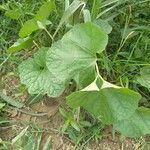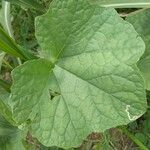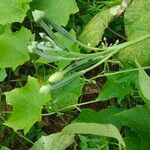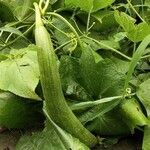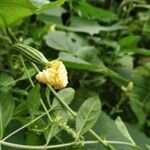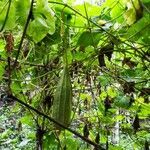| Therapeutic use
|
Antioxidants (aerial part), Anti-bacterial agents (fruit), Antifungal agents (fruit), Appetite stimulants (fruit), Bites and stings (fruit), Cardiotonic agents (fruit), Cathartics (fruit), Central nervous system depressants (fruit), Demulcents (fruit), Diet, food, and nutrition (fruit), Diuretics (fruit), Earache (fruit), Emetics (fruit), Expectorants (fruit), Furunculosis (fruit), Gastric mucosa (fruit), Headache (fruit), Hemorrhage (fruit), Hemorrhoids (fruit), Counterirritant (fruit), Jaundice (fruit), Joint diseases (fruit), Kidney diseases (fruit), Laxatives (fruit), Liver diseases (fruit), Migraine disorders (fruit), Miliaria (fruit), Skin diseases (fruit), Snake bites (fruit), Ulcer (fruit), Urination disorders (fruit), Amenorrhea (leaf), Anthelmintics (leaf), Anti-bacterial agents (leaf), Antifungal agents (leaf), Anti-infective agents, local (leaf), Antineoplastic agents (leaf), Cathartics (leaf), Conjunctivitis (leaf), Dyspepsia (leaf), Edema (leaf), Emetics (leaf), Expectorants (leaf), Hemorrhage (leaf), Hemorrhoids (leaf), Insecticides (leaf), Jaundice (leaf), Kidney diseases (leaf), Leprosy (leaf), Neuralgia (leaf), Scorpion stings (leaf), Snake bites (leaf), Splenomegaly (leaf), Toothache (leaf), Trachoma (leaf), Wounds and injuries (leaf), Calculi (root), Edema (root), Female urogenital diseases (root), Gonorrhea (root), Hemorrhage (root), Hemorrhoids (root), Laxatives (root), Abdominal pain (seed), Analgesics (seed), Anthelmintics (seed), Antifungal agents (seed), Anti-inflammatory agents (seed), Antioxidants (seed), Cathartics (seed), Demulcents (seed), Dysentery (seed), Dyspepsia (seed), Emetics (seed), Expectorants (seed), Eye pain (seed), Hemorrhage (seed), Jaundice (seed), Leprosy (seed), Skin diseases (seed), Skin diseases, infectious (seed), Splenomegaly (seed), Tooth diseases (seed), Urinary bladder diseases (seed), Vomiting (seed), Diuretics (stem), Jaundice (stem), Adenopathy (unspecified), Amenorrhea (unspecified), Anodyne (unspecified), Asthma (unspecified), Conjunctivitis (unspecified), Convulsion (unspecified), Diuretic (unspecified), Emetic (unspecified), Expectorant (unspecified), Jaundice (unspecified), Laxative (unspecified), Leprosy (unspecified), Meibomian Secretion (unspecified), Parturition (unspecified), Piles (unspecified), Purgative (unspecified), Scabies (unspecified), Scrofula (unspecified), Skin (unspecified), Snuff (unspecified), Sore (unspecified), Sore(Veterinary) (unspecified), Spasm (unspecified), Splenitis (unspecified), Splenomegaly (unspecified), Syphilis (unspecified), Tetanus (unspecified), Uremia (unspecified), Demulcent (unspecified), Dropsy (unspecified), Madness (unspecified), Tonic (unspecified), Abdominal pain (unspecified), Anemia (unspecified), Anticonvulsants (unspecified), Antidotes (unspecified), Antineoplastic agents (unspecified), Appetite stimulants (unspecified), Ascites (unspecified), Bronchitis (unspecified), Cathartics (unspecified), Constipation (unspecified), Cough (unspecified), Diuretics (unspecified), Edema (unspecified), Emetics (unspecified), Expectorants (unspecified), Fever (unspecified), Foodborne diseases (unspecified), Hemorrhage (unspecified), Hemorrhoids (unspecified), Hyperbilirubinemia (unspecified), Inflammation (unspecified), Kidney diseases (unspecified), Laxatives (unspecified), Lymphadenitis (unspecified), Muscle cramp (unspecified), Otitis media (unspecified), Skin diseases (unspecified), Skin diseases, infectious (unspecified), Snake bites (unspecified), Splenic diseases (unspecified), Tonsillitis (unspecified), Tuberculosis, lymph node (unspecified), Wounds and injuries (unspecified), Appetite stimulants (whole plant), Asthma (whole plant), Diuretics (whole plant), Laxatives (whole plant), Skin diseases (whole plant), Splenomegaly (whole plant), Diabetes mellitus (whole plant excluding root), Hypoglycemic agents (whole plant excluding root)
|
